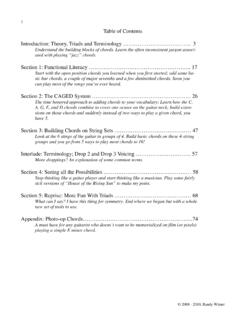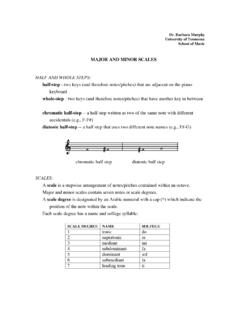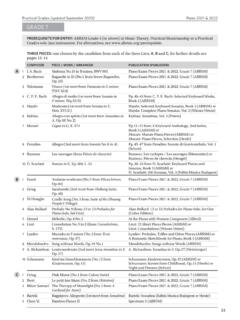Transcription of The Whole Scale Thing - Wimer Guitar
1 1 The Whole Scale Thing Introduction What is a Scale ? Is it the Do, a deer, a female deer; Re, a drop of golden sun stuff? (Have I just de-stroyed my street cred by quoting a Rogers and Hammerstein tune in the opening paragraph?) Why do gui-tarists get to a certain point in their development and start to obsess about these things? A Scale , according to the American Heritage Dictionary, is an ascending or descending collection of pitches proceeding by a specified scheme of intervals . (Anyone who has survived a college ear-training class understands those scheming intervals.)
2 So, a Scale is indeed the Do, a Deer stuff, and it is much more. Scheme of Intervals just means an organized pattern of intervals, or musical spaces, which can repeat over several octaves. Guitarists, as well as some people who play real musical instruments, obsess over scales because blasting through a Scale pattern at near relativistic speed is a great way to display one s tech-nical superiority, humiliate the competition and attract a mate, thus ensuring the survival of the genetic line. The poor creatures have no choice it s in their DNA. Before we get to the serious fun, let s cover some basics , just to makes sure we have a common vo-cabulary.
3 Basic Theory The space between two notes is called an interval. The smallest space you can have between two notes is a half-step, one fret on the Guitar . I like to think about note relationships spatially. Start with the chart below listing the chromatic Scale from C to C. Each box represents a single half-step. C C# Db D D# Eb E F F# Gb G G# Ab A A# Bb B C To understand the way we name the intervals we must first look at a major Scale . Below we ve re-moved the sharps and flats and we re left with the notes of a C major Scale . C D E F G A B C Intervals are named with numbers.
4 If we want to know the interval between a C and an E, we simply count: C, D, E; 1, 2, 3; the interval is a third. How far is it between C and A? C, D, E, F, G, A; 1, 2, 3, 4, 5, 6; This interval is a sixth. What is the interval between D and F? It s another third. But notice it s farther from C to E than from D to F. D E F C D E There are 4 half-steps between C and E and 3 half-steps between D and F. The larger interval is called a major 3rd and the smaller is a minor 3rd. The chart on the next page shows the interval names and the as-sociated number of half-steps between C and all the notes in the octave above C.
5 2 C Db D Eb E F Gb G Ab A Bb B C 0 1 2 3 4 5 6 7 8 9 10 11 12 unison minor 2nd Major 2nd minor 3rd Major 3rd Perfect 4th dimin-ished 5th Perfect 5th minor 6th Major 6th minor 7th Major 7th Perfect octave The first note is an F sharp (note the key signature) and the second is an A flat. That s a distance of 2 half-steps, or one Whole step. But, again, we have to consider the letter names of the notes, F and A. That s F, G, A; 1, 2, 3, so the interval has to be a kind of third. A major third is 4 half-steps, a minor third is 3 half-steps. This new beast is called a diminished third.
6 I tend to relate this stuff back to the intervals derived from the major Scale . In the C major Scale , C to A is a major sixth; C to A flat is a minor sixth. We can make that interval smaller (diminished, get it?) by either raising the the C to a C sharp or low-ering the A flat to an A double-flat. Either case would be called a diminished sixth. Will you need to under-stand diminished intervals to complete your knowledge of chords and scales? Not really - where it becomes relevant is in formal music theory study, generally around the second semester of college music theory.
7 It that s not your path then consider it knowledge for knowledge s sake. Not a bad Thing . Notice that the sharps have been removed from the preceding chart. There are other considerations be-sides the number of half-steps when identifying intervals: C to D# is not the same as C to Eb. Yes, D# and Eb are the same pitch, but when identifying intervals you also have to consider the letter names of the notes. Count the letters from C to D# - it s still C, D; 1, 2 - a second of some kind even though it s a D#. We call that space an augmented second. The chart below uses the sharps and the alternate names of the intervals.
8 C C# D D# E F F# G G# A A# B C 0 1 2 3 4 5 6 7 8 9 10 11 12 unison Aug-mented unison Major 2nd Aug 2nd Major 3rd Perfect 4th Aug 4th Perfect 5th Aug5th Major 6th Aug 6th Major 7th Perfect octave So, you ve got this interval Thing covered, right. Not quite. There is one (only one, I promise) more Thing to consider when naming intervals: mixed accidentals - the use of sharps in a flat key signature (or vice-versa). Consider the following: 3 A Brief Word About Modes The reason most of you are embarking on this study of scales is to find some new, cool sounding things to play when you re soloing.
9 When we start discussing the application of scales to chords we re talking about modes. A veritable cottage industry has grown out of making the study of modes complex. It s not. Simply put, the same Scale takes on a different sound when played against different chords. A C major Scale can be used over a C major 7 or an F major 7. Even though the notes are the same, the effect of the C Scale is different depending on which chord is being played. These effects are given names, sometimes exotic sounding like lydian, sometimes just a number, the 2 mode of a harmonic minor , for example.
10 One of the confusing Thing about studying scales on the Guitar is the lack of a standard set of names for the different fingerings. Many, many books try to solve this problem by applying modal names to finger-ings, based on the first note of the Scale shape. This is stupid. In improvisation, the modal designation is dependent upon the chord being played. A single fingering can be used against numerous chords, with a different modal name for each chord. So, a fingering pattern is not a mode! We will have a much more detailed discussion of modes when we talk about applying major scales at the end of the next section of this book.





